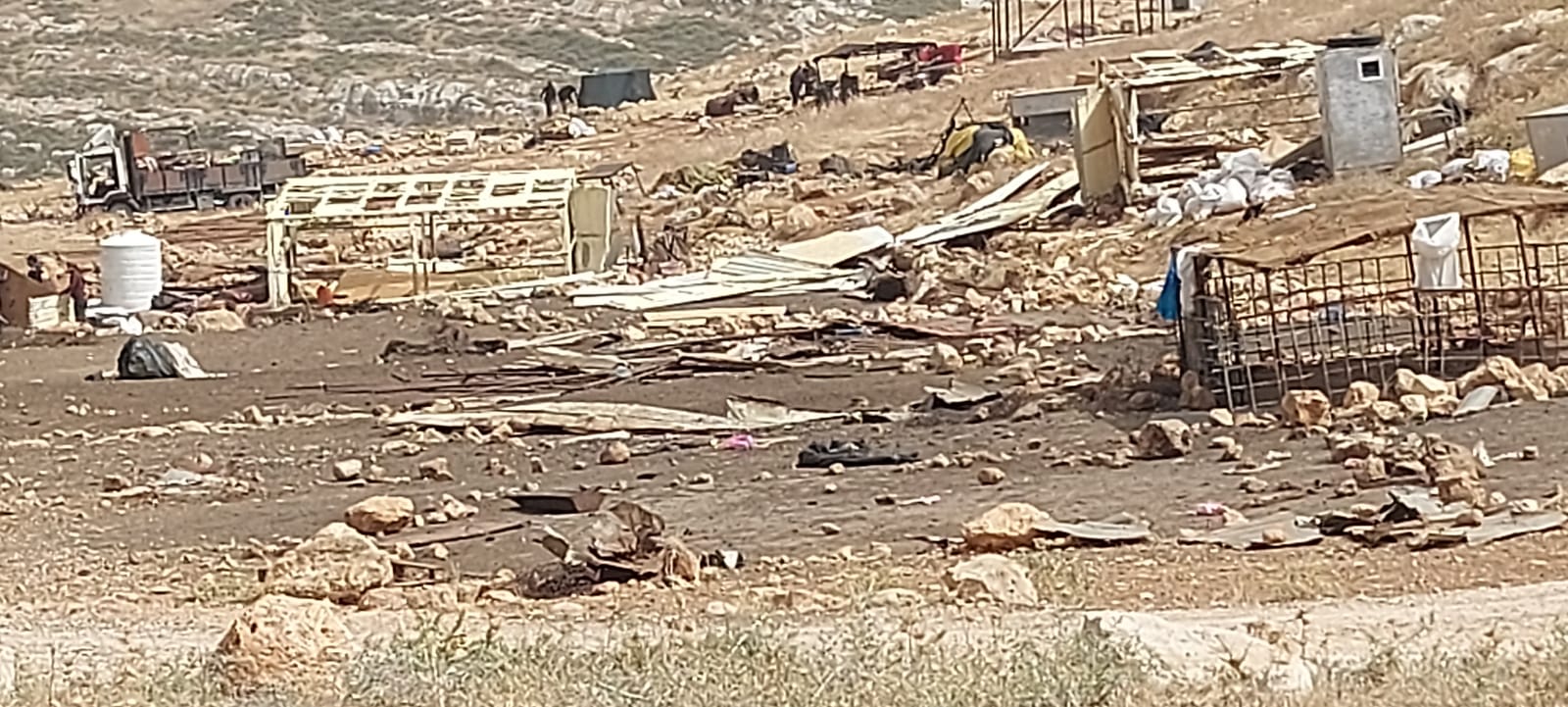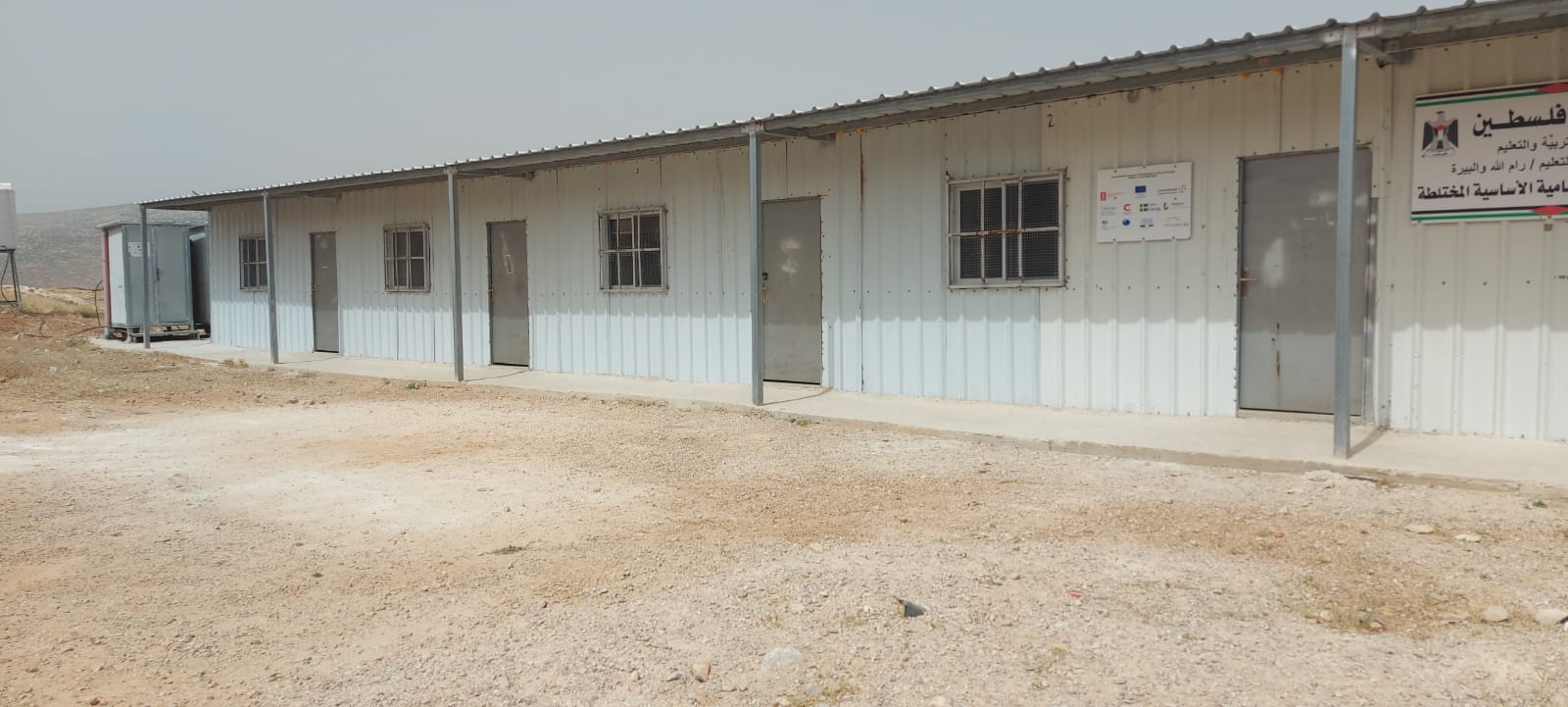Ein Samiya Bedouin residents in the face of unrelenting attacks by Israeli settlers on their homes, families, and livestock, the villagers took the difficult decision to dismantle their own dwellings and flee.
One week after being forced to hastily dismantle their homes due to relentless attacks by Israeli settlers, the Bedouin residents of Ein Samiya are still grappling with the trauma they have endured. The memories they share of their former life in Ein Samiya, playing on the land as children, provide a bittersweet solace amidst the harsh reality they now face.
Ibrahim Kaabneh, a young herder and new father, sat on an overturned bucket near the makeshift dwelling his mother, wife, and baby called home. The flimsy black tent stood with the support of wooden sticks and rocks, a feeble defense against the elements. Inside the tent, a stove, stacked pots, a couple of small cabinets, and a crib filled with blankets and mattresses were arranged on the hard dirt floor. Kaabneh’s wife Fatima and mother Amina sat on cheap mattresses, attempting to comfort their baby girl, Amal.
Outside the tent, the rest of the family’s belongings lay scattered – a couch, a full-size mattress, cabinets, and appliances. Kaabneh lamented the stark contrast to their previous home, once comfortable and well-equipped with electricity, insulation, and a solid floor. All of that was now lost.

The displaced villagers of Ein Samiya not only lost their homes but also the elementary school, their source of livelihood, and the prospect of a sustainable future as Bedouins in their new location. Government demolition orders hung over many structures in Ein Samiya, including the school, while settlers continued their attacks on the village’s inhabitants, regardless of age, and their livestock, even at the nearby spring where they gathered water.
Abu Najjeh Kaabneh, the distressed mukhtar or chosen leader of the Ein Samiya community, expressed their collective plight: “We are left without a home.”
Reaching the Breaking Point
In the face of escalating settler harassment and violence that had plagued the Bedouin community of Ein Samiya for the past five years, the decision to abandon their homes became an inevitable and terrifying choice. Night after night, settlers from illegal outposts in close proximity surveilled their activities, launching relentless attacks that involved rock-throwing, home invasions, and physical assaults on villagers.
Abu Najjeh, an elder in the community, revealed that the tipping point occurred when Atta Kaabneh’s flock of 75 sheep and goats was brazenly stolen in broad daylight, with Israeli police as witnesses. Settlers had falsely accused Atta of theft, using it as a pretext to have him detained and seize his entire herd.
“When we are unable to safeguard our livestock, life becomes untenable in this community,” expressed Abu Najjeh. Settlers had even taken photographs of all their flocks, sending a clear message that no flock was safe from their grasp.
Following Atta’s detention and the confiscation of his flock, settlers attacked the children and young individuals who were keeping watch over the village and its livestock, bombarding them with stones. As they attempted to escape, they found themselves cornered by other settlers who had strategically positioned themselves for further attacks. “They felt besieged from all directions,” recounted Abu Najjeh. “Nowhere was deemed safe.”
Abu Najjeh reached out to neighboring village councils and the Palestinian Authority’s Anti-Wall and Colonization Committee, initially seeking protection for the women and children. However, it became apparent that the only viable option was for the entire community to evacuate.
Amidst ongoing harassment and attacks by settlers, the community hastily departed a week and a half ago, leaving behind their homes and belongings. The settlers reveled in their triumph.
Exploiting grazing and violence: Uncovering the tactics to seize land
Over the course of five years, the people of Ein Samiya have witnessed the gradual decline of their once-thriving flock of 2,500 sheep to a mere 500, as numerous illegal shepherding outposts were established around their community. Despite these outposts being in violation of Israeli law, the Israeli government has failed to take effective action against them. These outposts, consisting of a single shepherd and a few volunteers, have increasingly become a tool to forcibly seize land from Bedouin communities since 2018. According to Israeli NGO Kerem Navot, there are now a total of 61 grazing outposts, with 50 of them emerging since 2018.
Documents from the Israeli government as early as 1981, revealed in a late 2021 report by Israeli NGO Yesh Din, expose plans to exploit grazing-permitted areas around settlements to secure land reservoirs for future settlement expansion. This agenda was advocated by then-Minister of Agriculture Ariel Sharon. Consequently, settlements such as Metzadot Yehuda, Shvut Rachel, Mitzpe Esthamoa, and others have emerged from areas originally designated solely for grazing purposes.
Shepherding outposts receive financial support from various organizations, including Amana, an offshoot of the ultranationalist Gush Emunim settler movement, and the primary driving force behind these outposts. Additional funding comes from HaShomer Yosh and the Jewish National Fund. Amana receives significant annual funding from local councils in settlements, which are themselves funded by the government. HaShomer Yosh, an association that dispatches volunteers to agricultural outposts in the West Bank, receives 65 percent of its budget from the State of Israel.
Adopting a strategy of “maximum land, minimum settler,” these shepherd outposts have played a crucial role in the seizure of substantial portions of land in Area C of the occupied West Bank, which remains under Israeli security and civil control. This situation was originally intended to be temporary under the Oslo Accords. According to Kerem Navot, these grazing-oriented outposts currently control nearly 7 percent of Area C.
Amana’s executive director, Ze’ev Hever, proudly boasts in the Yesh Din report that while settlements took approximately 100 square kilometers (39 square miles) over 50 years, shepherd outposts managed to claim double that area in just three years, from 2018 to 2021.
The complicit actions of the police, supporting settler violence and theft, made the situation unbearable. Wa’il Qut, a lawyer at the Jerusalem Legal Aid Center, which handled many of the villagers’ legal cases, noted that the police not only neglected to investigate settler attacks but actively targeted members within the Ein Samiya community. This collaboration between settlers, the army, and the civil administration to forcibly drive Bedouin communities away represents a clear violation of international law.
The success of displacing Ein Samiya sets a dangerous precedent that alarms nearby Bedouin communities and international stakeholders. Chris Holt, chief of party at the West Bank Protection Consortium, a partnership of nearly a dozen European states and several NGOs aiming to prevent the forcible transfer of Palestinians, expressed concern about settlers’ actions. In Ein Samiya, a pattern has emerged where settlers repeatedly terrorize communities, leading to their displacement and subsequent illegal settlement on the vacated land.
Emotional devastation: The painful loss of home and identity
Najjeh Kaabneh, the 55-year-old son of Abu Najjeh, now finds himself a few kilometers away from Ein Samiya, reflecting on the painful decision to leave his home behind. He expresses the sentiment that it would have been preferable to die in Ein Samiya rather than endure the emotional toll of dismantling his own house and relocating.
Over a period of three days, Abu Najjeh organized the movement of 21 out of 29 families in the village to privately owned land a short distance away. Unfortunately, the new location proved to be far from ideal. The Bedouin families found themselves situated near a polluting quarry and surrounded by cultivated farmland that they were unable to use for grazing. Initially, they had to make do with the rocky hilltop, using heavy machinery to flatten the land and create some livable space. The families spent their first nights sleeping outside and now, four or five families are forced to share cramped tents.
In the days that followed, Najjeh Kaabneh recounts how his wife and young children were finally able to find some peace in their sleep, free from the constant fear of settler intrusion. However, other villagers reported being unable to sleep for the initial days, still haunted by the trauma of displacement. Even in this new location, the community remained divided, with Ibrahim’s family and six others moving higher up on a rocky hill. There, they joined relatives who had experienced a similar mass displacement from nearby Ras al-Tin due to settler violence, demolitions, and coercive measures.
Through these remaining families, Ibrahim Kaabneh catches a glimpse of the future that awaits him if he chooses to stay. Some families from Ras al-Tin managed to install solar panels and construct more stable tents in the nearly year they have spent there. However, their traditional Bedouin way of life has been disrupted. Most families were forced to sell their sheep and goats, and the men had no choice but to seek employment in Israel or settlements.

Ibrahim worries that he will face the same fate, with limited grazing opportunities for his flock confined to a mere 200 meters (650 feet) on the barren hilltop. He is forced to keep his animals in a pen and purchase expensive fodder for them. The cost of water, with 10 cubic meters (10,000 liters or 2,642 gallons) amounting to 400 shekels, adds to the financial burden. Given that the livestock alone consumes nearly a third of the water each day, Ibrahim anticipates selling off all his sheep within a year and being compelled to work outside the area or in Palestinian territories.
Upon arriving at the new site, Ibrahim’s uncle decided to separate from his family, leaving the women and children in the new location while he took his sheep to an area further north with better grazing conditions. Ibrahim laments the difficult choices they face – either selling off their animals, dividing the family, or seeking work outside their traditional livelihood.
With community bonds weakening, the families struggle to settle into their new spaces. Although the landowner, typically involved in farming, is allowing them to stay for now, Abu Najjeh worries that their presence, along with their sheep, may eventually wear out their welcome. While they are currently in Area B, under Israeli security control and Palestinian civil control with reduced risk of demolition threats, their proximity to a hill in Area C raises concerns about potential violent displacement by settlers.
For the Kaabneh clan, this forced displacement is seen as another Nakba (catastrophe). Bedouins in historical Palestine have faced a long history of forced sedentarization, dating back to Ottoman times, and this marks the sixth time the Kaabneh clan, now united through patriarchal relations, has been forcibly displaced since
their initial expulsion from Be’er Sheva in 1948. Despite previous relocations, they managed to maintain their herding lifestyle in Ein Samiya for the past 40 years, until now.
Abu Najjeh expresses a lack of clarity about the future and is solely focused on protecting his family and ensuring they have acceptable shelter. Humanitarian workers assisting the community highlight the urgent need for psychosocial services, in addition to adequate housing, electricity, sanitation, affordable water, and suitable land.
The children, previously seen by foreign diplomats in school uniforms during a solidarity visit, now spend their days aimlessly wandering in the disjointed encampment. They are deprived of education, lacking a stable home, and silently coping with the trauma of settler attacks and forced displacement. Despite advocacy efforts from foreign countries and NGOs to protect the community and its donor-funded school, little progress has been made.
As Ibrahim Kaabneh’s wife and mother tend to their infant in the makeshift tent, and with his livelihood as a Bedouin shepherd rapidly fading away, Ibrahim expresses his frustration. Many organizations and foreign diplomats have come promising protection and support, but in reality, they have done little to assist. Ibrahim emphasizes that their actions amount to nothing.
“Nothing,” he states, exasperated.
SOURCE: AL JAZEERA


